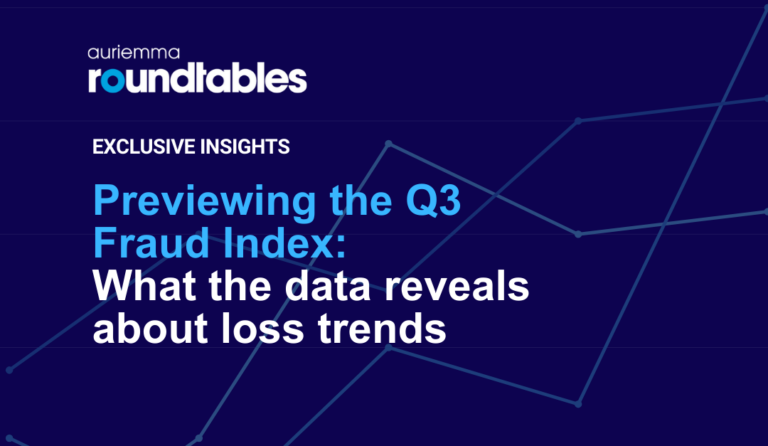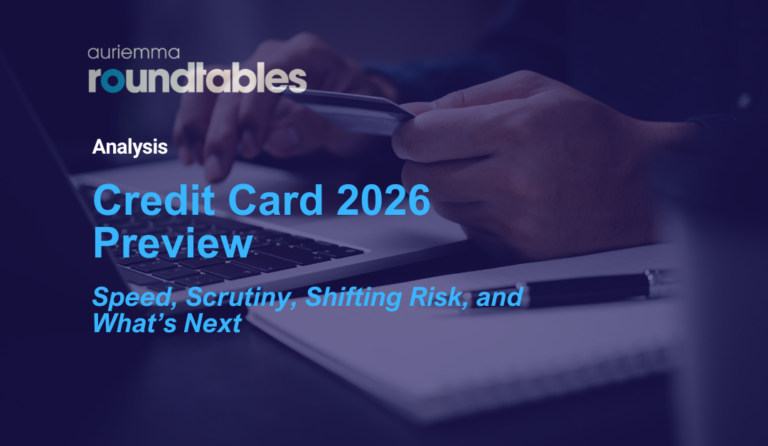August 26, 2025
Benchmarking Best Practices for FIs
Benchmarking is more than just a buzzword—it’s a disciplined process that helps organizations measure performance, identify gaps, and gain strategic clarity.
At its core, benchmarking involves comparing your business against peers or industry standards, but getting it right requires the right mix of benchmarking tools, well-defined KPIs, and thoughtful context that numbers alone can’t provide.
Partnering with benchmarking experts is crucial to ensure accuracy and utility in competitive benchmarking. Done well, benchmarking becomes a foundation for smarter decisions, guiding leaders toward both operational improvements and long-term advantages in a changing environment.
How to Start Benchmarking: Auriemma Roundtables’ Approach
Financial institutions generate vast amounts of data, but turning that information into actionable insight is rarely straightforward. For leaders focused on monitoring performance, mitigating risks, and planning strategically, the challenge is less about access to numbers and more about ensuring those numbers are comparable and contextualized. That’s where effective benchmarking analysis comes in.
Auriemma Roundtables has built a benchmarking program that reduces the burden of data preparation while improving the accuracy and value of results. By combining robust data aggregation, validation, and subject-matter expertise, our approach results in a powerful benchmarking capability—giving members the confidence to measure performance against peers, conduct competitive benchmarking, and uncover opportunities to strengthen strategy and execution.
Benchmarking Best Practice: Constructing Definitions for Apples-to-Apples Comparisons
One of the hardest parts of benchmarking is alignment: leaders need data that is accurate, consistent, and directly comparable across peers. Without clear benchmarking definitions, comparisons become misleading—especially in financial services, where scale and reporting standards vary widely. For example, fraud losses at a regional bank with a few hundred thousand accounts can’t be stacked against the same metric from a global institution without adjustments for size.
Auriemma Roundtables’ benchmarking program addresses this challenge head-on. By normalizing definitions, standardizing reporting periods, and adjusting for institutional scale, we transform disparate inputs into a reliable baseline. The result is true apples-to-apples benchmarking analysis that executives can trust.
“Clean benchmarking data is one of the most valuable things we deliver,” explains Charles Klimpel, Director of Data Strategy. “Members can focus on interpreting results rather than reconciling definitions or correcting anomalies.”
Beyond definitions, every benchmark is stress-tested. Using variance analysis and statistical benchmarking tools such as z-scores, anomalies are flagged and reviewed with reporting institutions before results are finalized. This hands-on process ensures that the data reflects genuine market trends—not errors, noise, or outliers—giving members confidence to act on the insights.
Understanding Benchmark Results: It Goes Beyond Numbers
Effective benchmarking analysis isn’t just about reporting numbers—it’s about uncovering the story behind them. Auriemma Roundtables enhances raw data with subject-matter expertise, ensuring that metrics are not only accurate but also meaningful in context.
The process begins with identifying KPIs that are both relevant to financial institutions and practical to capture consistently—such as fraud loss rates, dispute cycle times, or call center efficiency. These metrics should be anonymized and reported as ratios rather than absolute volumes, which safeguards confidentiality while still enabling members to conduct competitive benchmarking with confidence.
The real value, however, emerges in Roundtable discussions. Members interpret results together, connecting patterns in the data to industry realities.
“As important as the numbers are, the real insight comes from understanding why trends look the way they do,” explains Klimpel. “When dispute volumes spike, for example, we may connect that to our industry conversations. Recognizing the underlying driver changes the way institutions respond.”
By combining quantitative results with qualitative expertise, the benchmarking process reduces the risk of misinterpretation. Leaders not only see where they stand but also understand why, giving them the clarity to act strategically.
Approaches to Benchmarking: Why the Data Source Matters
Not all benchmarks are created equal. While federal agencies such as the CFPB, FDIC, or Bureau of Labor Statistics publish datasets relevant to financial services, these sources often face challenges: falling response rates, delayed publication, and limited applicability to day-to-day operations. For leaders seeking actionable benchmarking analysis, the result is incomplete insight.
Auriemma Roundtables addresses these gaps with a benchmarking program that combines strong participation, rigorous validation, and anomaly detection. Each dataset is reviewed, normalized, and refined—providing members with benchmarks that are both more reliable and more practical than what’s typically available from federal sources.
The difference is especially clear in operational data benchmarking. Regulatory datasets tend to focus on broad economic indicators or compliance metrics, but rarely capture the operational or efficiency-focused measures institutions need to manage performance. Auriemma’s approach goes deeper, offering metrics that speak directly to how organizations function and serve customers.
Operational metrics examples include:
- Contact center performance, such as handle time and first-call resolution
- Fraud operations data, including case volumes and resolution timelines
- Dispute management outcomes like chargeback win/loss ratios
- Digital adoption trends, authentication step-up usage, and other technology-driven benchmarks
This operational focus transforms benchmarking into a strategic advantage. Instead of broad statistics, members gain competitive benchmarking tools that uncover strengths, reveal pain points, and support resource allocation.
“Regulators and other data sources done have the same degree of access to leading U.S. financial institutions,” notes Klimpel. “But for financial institutions, they’re essential for evaluating performance, building business cases, and adapting to industry shifts.”
How Does Benchmarking Improve Performance?
The most valuable outcome of peer benchmarking is better-informed decision-making. With reliable tools and competitive data, institutions can quickly see where their performance diverges from peers and explore the underlying causes.
For example, if call center hold times run longer than industry benchmarks, executives might evaluate staffing levels, training programs, or new technology solutions. If fraud detection rates lag behind peers, investment in advanced prevention software may become a strategic priority. Benchmarks also validate strengths—reinforcing strategies that deliver better-than-average results.
Without an external comparison, organizations may struggle to know whether they’re leading or lagging the industry. “Institutions might know their own numbers, but they don’t know how those numbers compare to the broader industry,” says Klimpel. “The right data provides that frame of reference—turning raw metrics into actionable insight.”
Transforming comparison into context empowers leaders to identify gaps, allocate resources more effectively, and continuously improve performance.
Benchmark Use Cases and Examples in Financial Services
Benchmarking gives financial institutions a structured way to move beyond internal reporting and gain perspective on relative performance. Auriemma Roundtables’ approach emphasizes clean, validated data, expert context, and operational metrics often missing from federal or vendor studies.
By removing the front-end workload, ensuring apples-to-apples comparability, and layering interpretation on top of raw results, our program allows leaders to spend less time reconciling numbers and more time improving them.
If you’d like to see benchmarking examples tailored to financial services—ranging from call center performance to fraud operations—schedule a demo with Charles Klimpel, Director of Data Strategy to learn how Auriemma Roundtables can bring benchmarking insights to your institution.



